Seldom will you find places that are so raw and unadulterated, that despite all perfections and imperfections, you tend to develop a feeling of benevolence towards them. Such places do not evince anything but actuality; they do not obscure their infirmities, and hence, often occupy an unsurpassed stature in every traveller’s heart and soul. Welcome to Banaras, folks – a city which celebrates life, embraces death, eulogises its history and then, entwines these three together. It is a city which is impossible to put a filter on, a conurbation that has been unblemished, undiluted and unstained for centuries.
Mark Twain rightly put it:
Banaras is older than history, older than tradition, older even than legend, and looks twice as old as all of them put together.
Mark Twain

Banaras is a congregation of a myriad of experiences, so much that we found it impossible to cover it in just one blog article. Accordingly, we shall divide the Banaras expedition in two parts. In part 1, we shall focus solely on the Ghats of Banaras, while in part 2, we shall focus on different temples, the food and the city, in general.

Banaras – or Varanasi, as some might call it – has a unique way of expressing itself: on one hand, you can see the local kids, full of life, playing cricket on the ghats of the Ganges, while just a couple hundred feet apart, there is the Burning Ghat – Manikarnika Ghat – with its sombre processions and cremations. On one hand, the faith of people standing in line to visit the Vishwanath Temple will astound you, while on the other, the beliefs and stories of the sadhus sitting on the ghats, smoking their chillams, will bewilder you. While the street food and a multitude of chaat bazaars promise to satiate your taste buds, the bhaang thandai (made by drying, grinding, and soaking the buds and leaves of the Cannabis sativa plant to form a paste that is then added to flavoured milk) promises an experience to be remembered, if you are so adventurous.
Like I said, this city is unlike any other – it is eye-opening, unapologetic, and heterogeneous.
The Ghats of Banaras
It’s hard to put into words the all-encompassing significance of the Ganges to Indians. The revered ‘mother river’ of India originates in the Himalayas, snakes through northeast India, and empties in neighbouring Bangladesh. Considered a living goddess and featuring in many Hindu creation stories, the Ganges is sacred all along its 2,525-kilometre route and bathing in its waters (especially on auspicious days) is said to raze lifetime of sins.
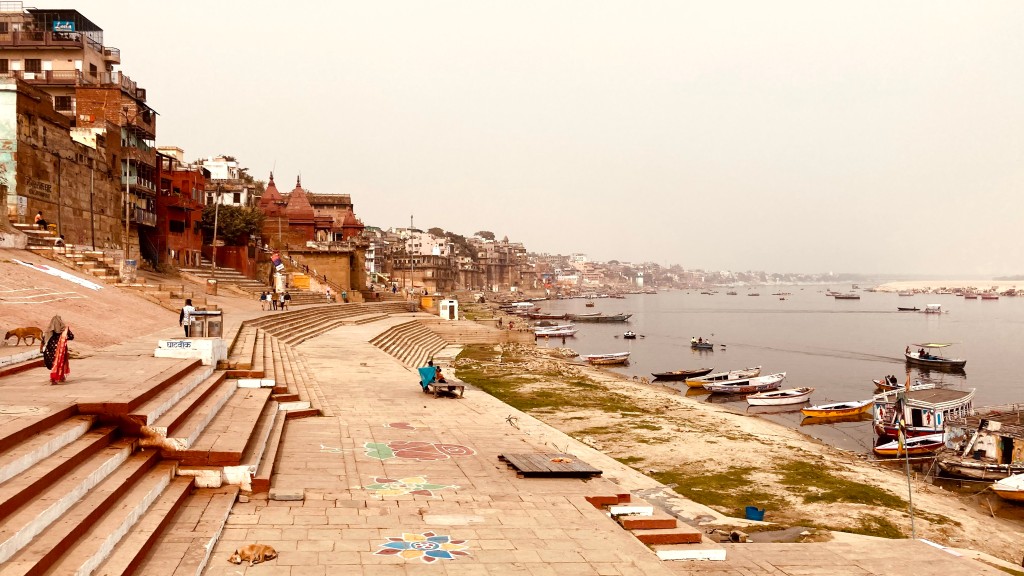
One of the reasons why people worldwide know Banaras, is because of its pristine ghats – the riverfront steps leading to the banks of the Ganges. There are a total of eigthy-eight ghats alongside the Ganges in Banaras. Most of them are used for bathing and performing various religious rituals, while few are used exclusively as cremation sites.

A majority of these ghats were built after 1700 AD, when the city came under the rule of the Marathas. Many of them such as Dashashwamedh, Manikarnika and Harishchandra Ghats are associated with legends or mythologies, and these sites have existed since time immemorial. Others such as Ahilyabai Ghat, Ganga Mahal Ghat, Chet Singh Ghat, among others, were built at some point later.
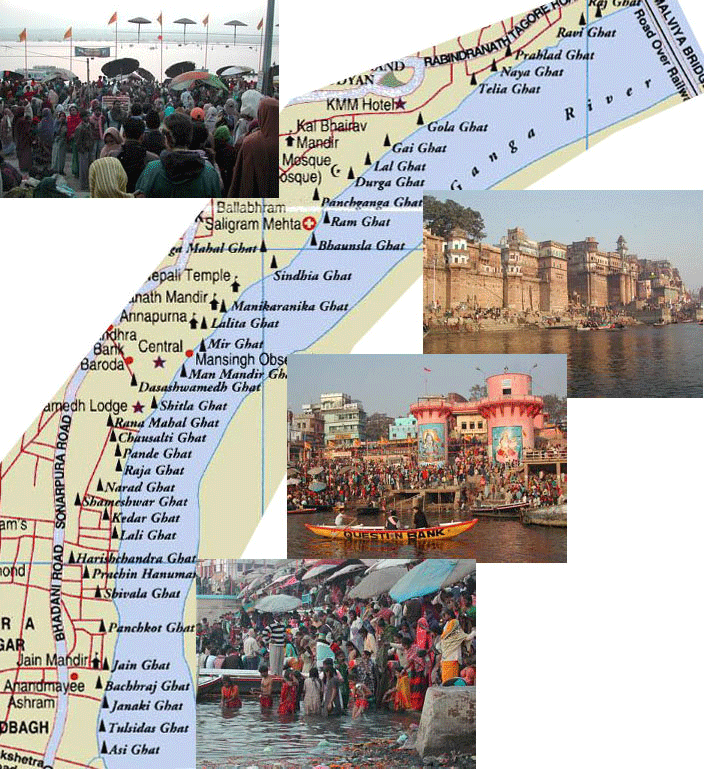
Subah-e-Banaras at Assi Ghat
Assi Ghat is where the Ganges meets River ‘Assi’ at the southern end of the city. This ghat is easily accessible by road, like most ghats in Banaras; however, unlike a couple others, this one is quite spacious, unflappable and less crowded. Assi Ghat is a well known pilgrimage site for Hindus, who bathe here before worshiping Lord Shiva in the form of a huge lingam under a pipal tree. A Ganga aarti ceremony is held at this ghat during early morning, at 5:30am, along with an evening aarti at 6:30pm; and trust me, attending the morning aarti here is perhaps one of the most mesmerising experience you will have in Banaras. Attending the morning aarti, or ‘Subah-e-Banaras’, as it is popularly known, promises one of the most picturesque sunrises ever!

The priests in-charge of performing the aarti sport dhoti and kurta well-tied with a long gamcha (or towel). They prepare the set-up by gathering five elevated planks, a layered brass lamp, flowers, an idol of Ganga Devi, conch shell, incense sticks, and other ritual paraphernalia. Eager devotees throng the site from across the city to witness the awe-inspiring spectacle; many others take a boat ride from the opposite banks of the Ganges. Only the learned pundits of Vedas and Upanishads (ancient Hindu literature) are involved in performing the aarti.
Assi Ghat is located near the city-centre, and is perfect if you would want to spend some time just sitting on the river banks, soaking in all the charisma Banaras brings with it!
The ghats in Banaras are best to be explored on feet, like I did. If you can walk for a good eight to ten kilometre along the steady flowing Ganges, you are promised an experience of a lifetime! It would take around three hours to walk this stretch of ghats, starting from Assi Ghat, all the way to Gola Ghat. While you would have covered most of the well known ghats in this stretch, one might as well continue ahead for around two kilometre to Raj Ghat, if you are among the peripatetic folks! If no construction work is ongoing, you might just hop from one ghat to the next without ever having to walk away from the river bank.
Evening Aarti at the Dashashwamedh Ghat

© Cobblestone Chronicles
This is one of the oldest and the most sacred ghats in Banaras. Dashashwamedh Ghat is most famous for its evening Ganga aarti, which is an elaborate and lively ceremony that takes place at dusk everyday. Amid blowing of conch shells, ringing of bells, clanging of brass cymbals and chanting chorus of mantras, priests venerate the Ganga, the lifeline of Varanasi, with brass lamps that rise several tiers. The preparations for the aarti are similar to the morning aarti at Assi Ghat, however, this one is held at a much larger magnitude, is much grander and is attended by many more people.
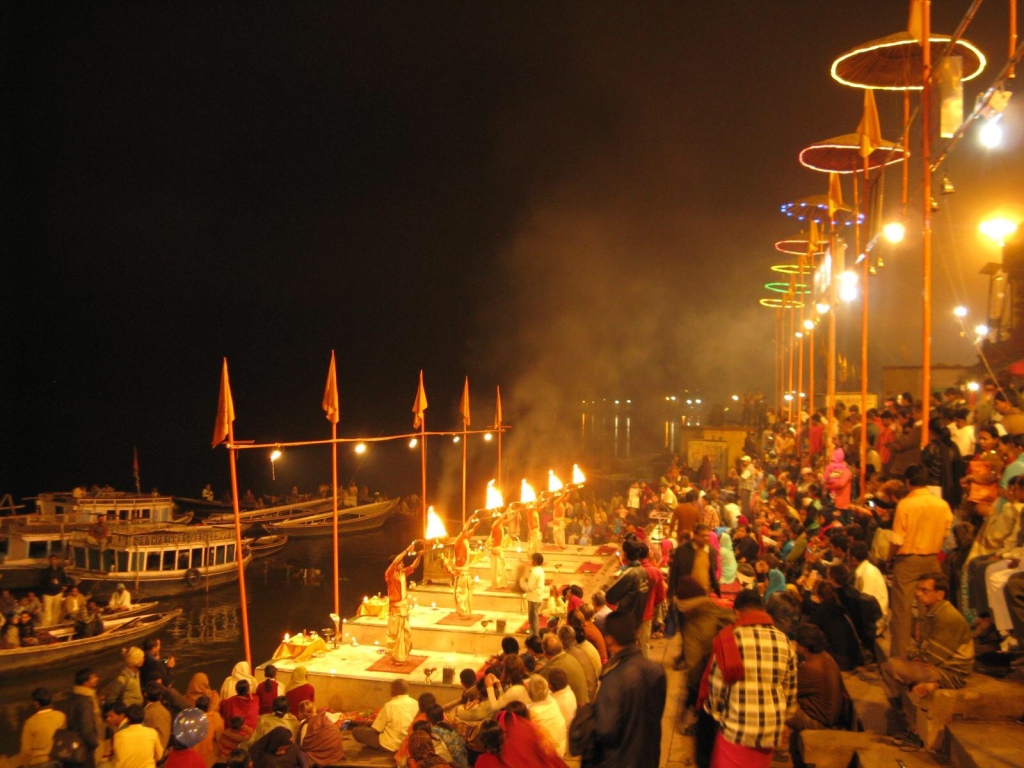
The aarti lasts about 45 minutes, during which the devotees float smaller diyas on leaf platters in the river as an obeisance to the holy Ganga. As the sunlight recedes, the innumerable lamps flowing in the water make for an unforgettable sight. The hour-long ritual can be watched from the ghat or boats moored at the river bank.
Manikarnika Ghat – The Burning Ghat
Manikarnika Ghat, the main burning ghat, is the most auspicious place for a Hindu to be cremated. The dead bodies are handled by outcasts known as doms, and are carried through the alleyways of the old town to the holy Ganges on a bamboo stretcher, swathed in cloth. The corpse is doused in the Ganges prior to cremation.
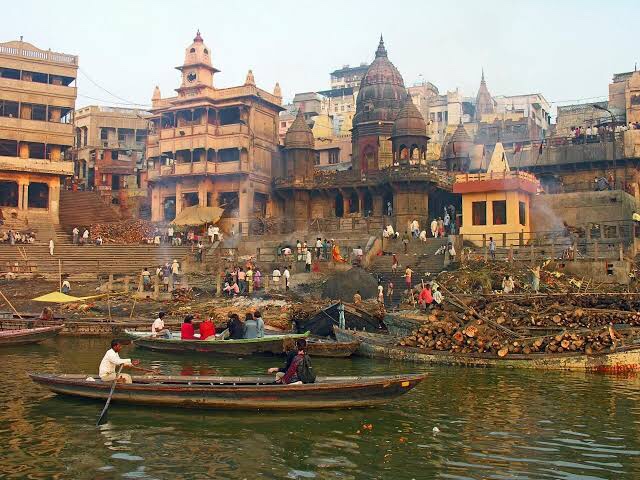
© Cobblestone Chronicles
This Ghat is one of the oldest ghats in Varanasi and has been accorded the highest position among other ghats by the holy scriptures in Hinduism. It is believed that if a person is cremated here, he or she immediately attains moksha (salvation). It is bound on both sides by the Scindia Ghat and Dashashwamedh Ghat. Like all the other ghats in Varanasi, the Manikarnika Ghat is surrounded by a fascinating mythological story which also tells us how it acquired its name. It is believed that when Goddess Adi Shakti, or Goddess Sati, jumped into the fire and immolated herself, Lord Shiva carried her burning body to the Himalayas. There, he was immersed in unending sorrow. Lord Vishnu, moved by his plight, sent forth his Divine Chakra (one of his weapons) which cut Goddess Adi Shakti’s body into 51 pieces. Each of the place where her pieces fell on Earth were declared as a Shakti Peeth. Because her earrings fell at this ghat, it was established as a Shakti Peeth and named Manikarnika since Manikarna in Sanskrit means ‘ear rings’.
While visiting this ghat is open to all, one must remember to respect the proceedings and families attending those. While photography is permitted here, if you decide to visit this place, make sure you won’t be disturbing any rituals.

What stands out when when you walk along the ghats is the paradigm shift – the atmosphere, the vibes, they all change continuously. At times, you are surrounded by hundreds of devouts; the very next minute, on the adjacent ghat, you will find nothing but a couple sadhus, smoking their chillams, telling stories of life and philosophy to the travellers nearby. Next to that, you can see the mourning families at Harishchandra Ghat or Manikarnika Ghat, which are the only two Ghats where cremations are allowed.
Harishchandra Ghat

Harishchandra Ghat is yet another domain of the Dom Rajas. This cremation ghat is a smaller one (as compared to Manikarnika Ghat) and is linked to the story of King Harishchandra who was sent into exile as a test by the famous sage Vishvamitra. During the exile, he worked for the Dom Raja and did cremations on this particular Ghat; thus, the name. There are fewer cremations that take place traditionally out here.
Darbhanga Ghat & Munshi Ghat
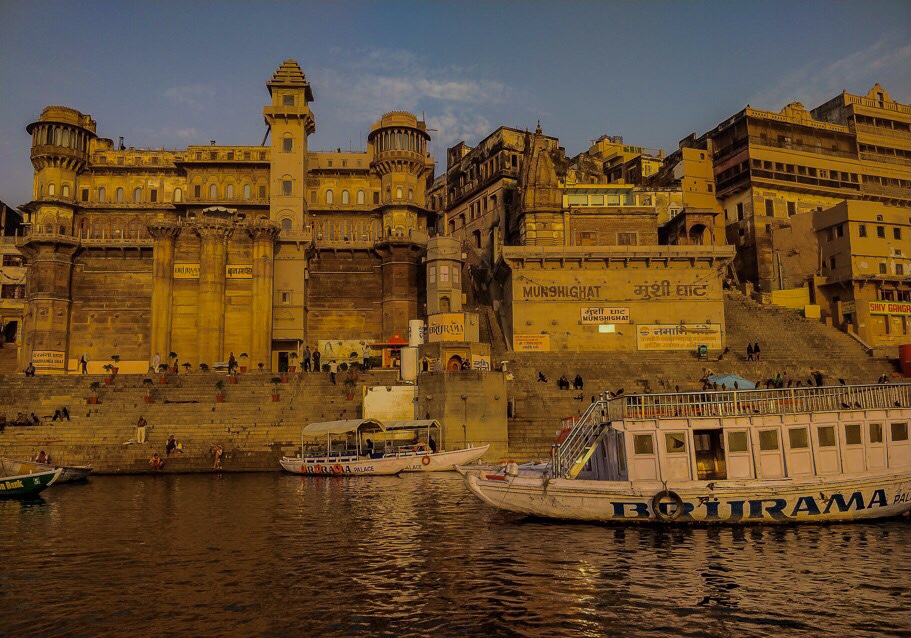
Technically these are two ghats next to each other but the boundaries between them are sketchy. However, they are appealing owing to the Darbhanga Palace on it. The palace was built by a Bihari Royal family, which has been converted to a heritage hotel now. It might be a good idea to stay here just for the views. To an extent, these two ghats do remind of the royal palaces in Rajasthan, and the sheer size and beauty of the structures is worth all the attention they get!
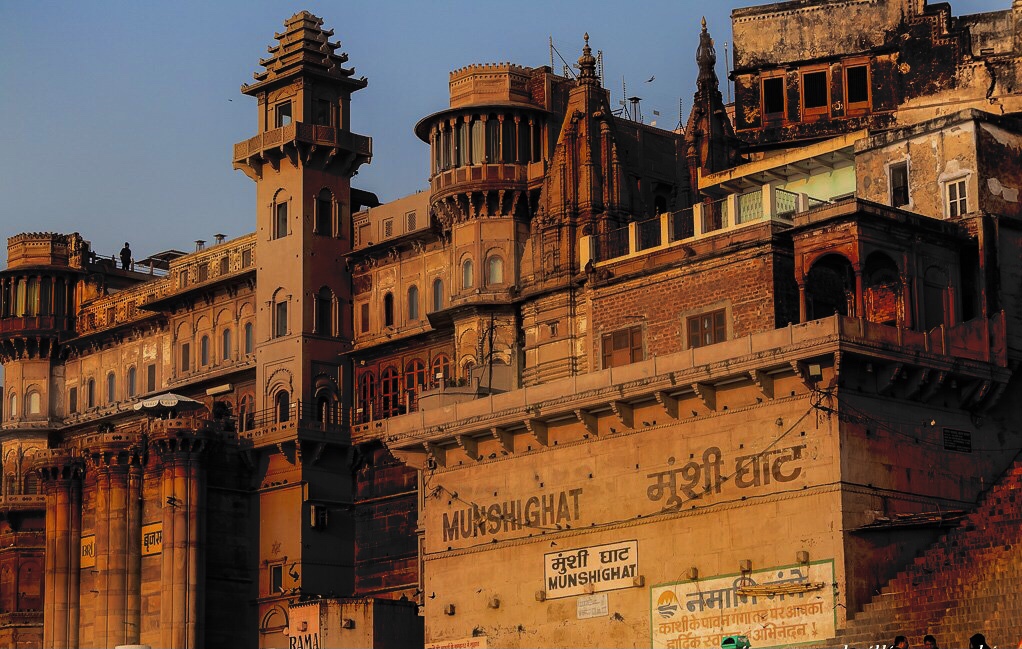
While there are many more Ghats to be seen and most importantly, to be experienced, in my opinion, the Assi Ghat, Dashashwamedh Ghat, Manikarnika Ghat, the Harishchandra Ghat, Darbhanga and Munshi Ghat perfectly tell us the story of this sacred city. Some ghats are meant to pray, others are meant to mourn. Some ghats are known for their gigantic structures, others are known for their simplicity. Talk about diversity, and the ghats of Banaras shall show you the epitome of it!
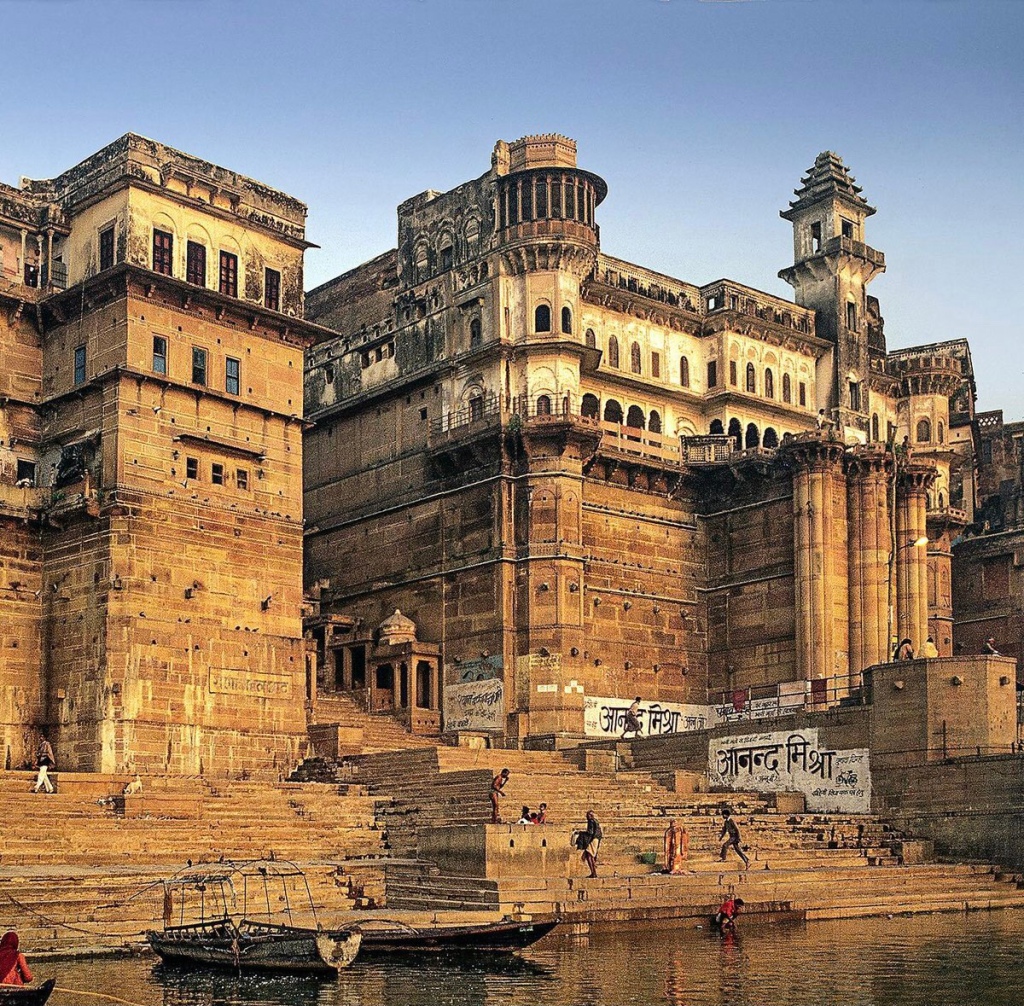
The ghats in Banaras not only showcase the rich cultural heritage that this city is home to, they form the backbone of the history and legend that this city has to offer.
Just walking along the banks of the Ganges from one ghat to the other will expose you to a multitude of details and annals, depicting the ‘Unity in Diversity’ in this city! While the Kedar Ghat is inspired by the Dravidian-style temple on the banks, and is primarily a popular pilgrim site for South Indians, the Jain Ghat is home to a few Jain temples and a sacred spot for the Jain community.


The Chet Singh Ghat, on the other hand, is home to very impressive fortress named after its builder. Maharaja Chet Singh built this in the late 1700s when he was the ruler of this princely state of Banaras. His disagreements with the first British Governor-General led to a war between the two. It is rumored that he escaped using a rope made of turbans. He did lose the war but even now, his legacy lives on in the form of this stunning building.

© Cobblestone Chronicles
Every ghat in Banaras tells a story, all you need to do when you visit these pristine ghats, is to observe the details, fathom the cultural significance and embrace the ancestry and legacy of these relics!
The ghats can either be explored on feet, like I said before, or one can take a boat ride to gather a different perspective. The boat rides during sunrise and sunset are notably expensive, but worth every penny! The way I did it, you can attend the morning aarti at Assi Ghat, take a boat ride immediately after sunrise (which costs around INR 200-250 per person), which will allow you to see all the ghats awaken in the golden morning sun. The boat shall take you from Assi Ghat, all the way north of Manikarnika Ghat, and bring you back at Assi Ghat. It’s an experience not to be missed, and if you are that adventurous, you might as well take dip in the Ganges while you are at it!

In one way or the other, the Ghats of Banaras are always vibrant – be it during the dawn, dusk or at night. You will encounter prosperity and poverty – and somewhere after having seen the inevitability of death at Manikarnika Ghat and the celebration of life at Dashashwamedh Ghat so closely, you will find it hard to solicit the difference between the two.
I read this quote in a small shop selling Banaras paan just outside Assi ghat, which made quite an impact –
Enlightenment, and Death which comes before it is the primary business of Varanasi.
Tahir Shah
Banaras is a place where you feel like a dweller and an alien at the same time. It is ancient and contemporary, nebulous and bare, all at once. The Ghats are overwhelmingly authentic, and subtlety is not their strong suit; they are downright raw, and undeniably unfiltered!
Read part 2 of this blog which shall cover the temples, food and the city, in general – Banaras, Unfiltered! – Part 2.

Leave a comment